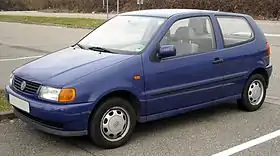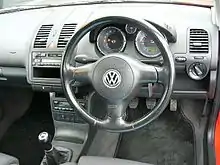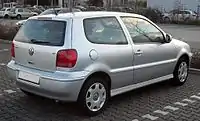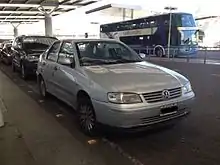Volkswagen Polo Mk3
The Volkswagen Polo Mk3 is the third generation of the Volkswagen Polo supermini car and was produced from 1994 until 2003, with a facelift at the end of 1999. It was available in hatchback, sedan and wagon body styles. Hatchback didn't share the same platform and Seat Ibiza, but saloon and estate models were rebadged Seat Córdoba.
| Volkswagen Polo Mk3 (6N/6KV) | |
|---|---|
 | |
| Overview | |
| Manufacturer | Volkswagen |
| Also called | Volkswagen Derby |
| Production | 1994–2003 (Germany) 1996–2009 (Argentina) |
| Assembly |
|
| Body and chassis | |
| Class | Supermini (B) |
| Body style | 5-door hatchback 3-door hatchback 4-door saloon 5-door estate |
| Layout | Front-engine, front-wheel-drive |
| Platform | Volkswagen Group A03 platform |
| Related | SEAT Arosa SEAT Ibiza Mk2 SEAT Córdoba Mk1 SEAT Inca Volkswagen Lupo Volkswagen Caddy Mk2 |
| Powertrain | |
| Engine | 1.0 L I4 (petrol) 1.3 L I4 (petrol) 1.4 L I4 8-valve (petrol) 1.4 L I4 16-valve (petrol) 1.6 L I4 8-valve (petrol) 1.6 L I4 16-valve (petrol) 1.8 L I4 8-valve (petrol) 1.4 L I3 TDI (diesel) 1.7 L I4 SDI (diesel) 1.9 L I4 D (diesel) 1.9 L I4 SDI (diesel) 1.9 L I4 TDI (diesel) |
| Transmission | 5-speed manual 4-speed automatic |
| Dimensions | |
| Wheelbase | 2,407 mm (94.8 in) (hatchback)[1] 2,444 mm (96.2 in) (sedan, wagon) |
| Length | 3,715–3,743 mm (146.3–147.4 in) (hb.) 4,138 mm (162.9 in) (sedan, wagon) |
| Width | 1,632–1,655 mm (64.3–65.2 in) (hb.) 1,640 mm (64.6 in) (sedan, wagon) |
| Chronology | |
| Predecessor | Volkswagen Polo Mk2 |
| Successor | Volkswagen Polo Mk4 |
The hatchback underwent a major facelift in 2000, while the saloon and the estate received only minor refinements.[2] It now had a more different exterior and interior design than the also facelifted Seat Ibiza.[3] In 2001, it was discontinued and replaced by its successor, the Volkswagen Polo Mk4, but it continued production in Argentina, where the saloon was facelifted in 2004,[4] receiving the exterior design applied to the facelifted Seat Córdoba and the interior of the facelifted Volkswagen Polo.[5]
Overview

.jpg.webp)
The MK3 Polo was unveiled on 31 August 1994, and was immediately available in left-hand drive form for continental markets,[6] and was launched on the right-hand drive UK market in October that year. It was the first completely new Polo to be launched since the MK2 model in 1981; although that model had undergone a major restyle in 1990. It was also the first version of the Polo to be available with five doors as well as three doors. The initial range consisted of new 1.0 and 1.6 petrol engines; the 1.3 unit was carried over from the previous Polo but discontinued a year later in favour a new 1.4 unit, which became available around the same time as a 1.9 diesel and turbo-diesel models. The availability of a diesel Polo for the first time on the UK market brought it into line with almost all of its competitors, while the Polo was the last mainstream supermini in Europe to become available with five doors - five years after the Ford Fiesta was first available with five doors, and between seven and 11 years after the launch of five-door superminis including the Opel Corsa, Fiat Uno, Nissan Micra and Peugeot 205.[7]
The platform used for this model was all new, although it shared some components with SEAT Ibiza Mk2 which had been launched a year earlier. Although the dashboard and a number of mechanical components, including some engines and rear suspension, were shared with the Ibiza, outwardly the Polo models were entirely different with no body panels shared with the SEAT model.
Initially, only three- and five-door hatchback versions were available. In 1995, four-door saloon ("Polo Classic/Sedan/Derby") and five-door estate ("Polo Wagon/Variant") versions were added to the range — these were badge engineered and mildly restyled versions of the SEAT Córdoba (the saloon and estate versions of the Ibiza). They were referred to internally by VW as the Typ 6KV, and shared body panels with the SEAT model rather than the hatchback models. A two-door coupe version of the Cordoba (the SX) was also produced, but the Polo was never made in this form.
A convertible version was not produced, although a version with an electrically sliding full length sunroof, called the Polo Open Air, was available.
Engines
Initially the car was available with the 1043cc putting out 45 PS (33 kW; 44 hp), and the 1272cc putting out 55 PS (40 kW; 54 hp) engines from the previous generation Polo, along with a new 1598cc unit. A new 1.4L engine replaced the 1.3L in October 1995. In September 1996 the 1043cc engine was replaced by an all-new aluminium block multi-point injection 999cc developing 50 PS (37 kW; 49 hp). The Classic and Variant models featured a 75 PS (55 kW; 74 hp) or 100 PS (74 kW; 99 hp) 1.6L and a 64 PS (47 kW; 63 hp) 1.9L diesel and a 1.8L (82 kw) lux model with electric front windows. For the first time, a turbo-diesel engine (1.9L) was available in a Polo, although only in the 6K models. Due to its smaller engine bay, the standard 3 and 5-door 6N did not get a turbo-diesel engine until the facelift in 2000.
The car was available with the following engines:
- 1,043 cc straight-4 petrol 33 kW (45 PS) (1995–96)
- 1,272 cc straight-4 petrol 40 kW (55 PS) (1995–96)
- 1.6 L straight-4 petrol 55 kW (75 PS) (Engine Code – AEE)
- 1.4 L straight-4 16-valve petrol 74 kW (100 PS) (Engine Code – AFH) stock but tuned 1.4 16v 75 Ps version
- 1.4 L straight-4 16-valve petrol 55 kW (75 PS)
- 1.4 L straight-4 petrol 60 PS (44 kW) (Engine Code AUD)(1996–)
- 999 cc straight-4 petrol 50 PS (37 kW) — all-new aluminium block multi-point injection (1996–)
- 1.6 L straight-4 16-valve petrol 88 kW (120 PS) (LHD European GTI model only)
- 1.6 L straight-4 petrol 74 kW (100 PS) (6K saloon and estate models only) Engine code AFX.
- 1.6 L straight-4 petrol 55 kW (75 PS) (6K saloon and estate models only)
- 1.8 L straight-4 petrol 82 kW (111 PS) (6K saloon and hatchback models only) Engine code AFV.
- 1.9 L straight-4 diesel 47 kW (64 PS)
Trim levels
The Polo Mark 3 was much better equipped than its predecessor. A range of models featured items such as colour-coded bumpers, heated/electrically adjustable mirrors, four speaker stereo, pollen filters, central locking, rear head restraints, split rear seats, fog lights, alloy wheels, and airbags. The car was available originally in four trim levels ranging from the L at the bottom level of the scale through the CL and GL to the range topping GLX model. The range-topping was the Polo SE or Special Equipment; it featured a number of features from higher spec models such as the GLX bumpers, Sport Rader alloy wheels, tinted rear light clusters and clear indicators.
Unlike the Volkswagen Polo Mk1 and Volkswagen Polo Mk2, trim levels were not the same across Europe; the United Kingdom's were L, CL, GL, GLX, 16v (later E, S, SE and GTi); models sold in Europe had trim levels which were individual to the country they were marketed in. The facelift at the end of 1999 saw the introduction of E, S and SE trim levels, as well as the 1.6 GTI which was the first to be sold in Britain.
An all-new Polo was unveiled at the end of 2001, although the saloon and estate models continued in production until 2003, and were not replaced with any new additions to the newer Polo range.
Variants
Sporting variants
.jpg.webp)
Sporting variants were not introduced initially, and a supercharged G40 version of the Mark 3 was never made, but a GTI model introduced in 1998 catered for the hot hatch market. With a limited production run of 3000 units, the 6N GTI was available only in continental Europe. Featuring a 1.6 16V 120 PS (88 kW) version of the unit that would later be found in the Mark 3F model, the car came with 15" BBS alloys and could sprint to 100 km/h (62 mph) in just 9.1 seconds. The 16V, introduced to replace the GLX, was one of the most popular Mark 3 versions with modifiers, it used a 1.4 16V unit pushed to 100 PS (74 kW) as standard. This car was not a pure sporting model, and with a 0–100 km/h time of 10.6 seconds and a 190 km/h (118 mph) top speed, it was not as fast as the sporting Ibiza model (which used a 2.0 L 16V engine). The Polo GTI was often seen as overpriced for the performance it delivered.
Polo GTI

Between 2000 and 2002 VW offered two sporting models, the 16V and GTI. The 16V came with the 1.4 16V 100 PS (74 kW) engine and had options such as 15" Spa alloys and air conditioning. However more interest was in the GTI. Available only in hatchback form, the GTI was powered by a 1.6 16V 125 PS (92 kW) engine with variable valve timing, making it the most powerful Polo to come out the factory to date. External changes gave the car the looks to match its power. Deeper front bumpers with honeycomb mesh inserts, side skirts, fog lights, a honeycomb mesh grill and 15" BBS split rims suited the car well. There were also standard extras such as Climatronic fully automatic air conditioning, Xenon headlights (with a headlight washer system), a 6 disc CD autochanger, exclusive sports interior with leather steering wheel and gearstick, chrome inserts and driver aids such as ABS with EBD and an EDL (a system to aid traction). Leather and satellite navigation were also optional extras. The Mark 3F Polo GTI however missed the new six-speed gearbox that was introduced in the smaller Lupo GTI.
Polo Harlekin

In Europe, a limited edition "Harlekin" model was released in 1995. The Polo Harlekin featured multi-coloured body panels with a symmetrical combination of Flash Red, Ginster Yellow, Pistachio Green and Chagall Blue. Harlekin Polos used the 1.6 petrol engine and featured special "Joker" pattern seats and bespoke gear knob and steering wheel. Originally limited to 1,000, around 3,800 of this series were produced. 2,500 Polo Harlekins were made in the UK between 1996 and 1998.
Facelift


The facelifted Mark III Phase II[8] (or Typ 6N2; sometimes referred to as the Mark IIIF or "Mark 5" by enthusiasts) was released in 1999.[9][10] The hatchback models featured updated styling including new headlights and bumpers and an all new interior based on that of the Lupo. Although the car was similar in appearance to the Mark 3 (the bodyshell was fully galvanised and stiffened but not fully redesigned, although some panels were changed), Volkswagen claimed that 70% of the components were new. Power steering, antilock brakes and twin airbags were made standard. The saloon and estate versions received the new interior, but not the full exterior facelift. Also, the three-cylinder 1.4-litre TDI engine was introduced for the three and five-door hatchbacks.
Specification options ranged from power steering, tinted glass, split rear seats, electric windows and cup holders to ABS, air conditioning, Xenon headlights and satellite navigation. Thirty-two models with seven engines ranging from the 1.4 diesel to the 1.6 L 16V GTI made the choice of Polo the widest ever seen. The base model was the Comfortline with the option of no less than 5 engines ranging from the 1.0 50 PS (37 kW) to the 1.9 TDI unit found across the VW range, producing 90 PS (66 kW). The 1.0 L hatchback was considered cheap for the build quality and spec list when compared to other cars. Then came the Trendline and Highline models. With engine options ranging from 60 PS (44 kW) to a 110 PS (81 kW) diesel they offered a range of features usually found on the more sporty models but without the insurance or running cost woes.
Volkswagen also introduced a GTI version of this facelift, this time also available outside of Germany. The GTI is equipped with a further developed 1.6l 16v engine from the 6N with 92 kW (125 hp), this time with VVT (Variable Valve Timing) which activates from 5,000 revs, making the engine sound more exuberant. The GTI is recognizable by original Xenon lighting with headlight washers (the only one in the 6N2 range), honeycomb grills, 10mm factory lowered suspension, a thicker front lip and original 15" BBS rims with 195mm wide tires.
Both versions of the Mark III Polo were strong sellers in the United Kingdom and strong competitor for the likes of the Fiat Punto and Nissan Micra. At the time of its launch, it was arguably the best small car on sale in Europe in terms of build quality and "upmarket" feel, although its ride and handling was generally not considered to be as good as that of the Ford Fiesta or Peugeot 206. The 1.4 TDI was considered the best in the range due to its reliability, fuel consumption, and relative power, for a small engine.
Awards
- 1999 Used Car Buyer Greatest Used Car Buy Awards – Best Economy Car
- 1998 Top Gear Magazine Top Cars – Best Supermini
- 1997 Which? Magazine Best Buys – Best Supermini
- 1997 Auto Express New Car Honours – Best Supermini
- 1997 Complete Car of the Year Awards – Best Supermini
- 1996 Semperit Irish Car of the Year
- 1995 What Car? – Car of the Year
Outside Europe
Asia
In some Asia Pacific markets, the Polo Classic (1995-2002MY) was sold as the Derby.
In China, FAW-Volkswagen simply rebadged the SEAT Cordoba without the exterior modifications of the European Derby (i.e. rear and front bumpers/headlights). It was sold & assembled as the FAW-VW City-Golf during 1996. This version was also sold in Russia as the Volkswagen Polo Classic S. It is not to be confused with the Canadian Mark 4 City Golf released in 2006 in Canada.
Latin America

In Argentina, Volkswagen produced the Polo Classic, which was sold as the Derby in Mexico, and the Volkswagen Caddy, a SEAT Inca-derived van, which shares the same platform and front end styling as the Polo Classic. The Polo Classic (Typ 6K) and the Caddy (Typ 9K) have been produced since 2000. All the facelifted models are Argentine-built models.[11]
Latin America had its own trim levels, although some of the trim level names were similar to their European counterparts. The CL and GL were available from 1996 onwards in Brazil; these were similar to their European counterparts, although slightly more expensive due to import tariffs.
Related models
- The SEAT Ibiza Mark 2 was based on the same platform as the Mk3 Polo Classic and Variant, as were the SEAT Inca and Volkswagen Caddy panel vans.
- The South African built Volkswagen Polo Playa was a rebadged version of the SEAT Ibiza Mark 2, and was sold instead of the European Polo in South Africa until the introduction of the Polo Mark 4.
- The Volkswagen Lupo and SEAT Arosa city cars were based on a shortened version of the 6N platform, and shared many components.
See also
- Volkswagen Polo for an overview of all models
- Volkswagen Polo Mk1
- Volkswagen Polo Mk2
- Volkswagen Polo Mk4
- Volkswagen Polo Mk5
- Volkswagen Polo Mk6
References
- "Volkswagen - Amarok Dubbele Cabine, Beetle, Beetle Cabrio, Bora, Bora Variant, CC, Caddy Combi, Corrado, specs, engine, bodywork, specificatio". Retrieved 14 July 2015.
- "Archived copy". Archived from the original on 2008-12-27. Retrieved 2008-10-16.CS1 maint: archived copy as title (link)
- "Seat - Alhambra, Altea, Altea FreeTrack, Altea XL Stationwagon, Arosa, Cordoba, Cordoba 2-drs, Cordoba SX, specs, engine, bodywork, specificatio". Retrieved 14 July 2015.
- "Historia < Volkswagen Argentina < Volkswagen Argentina". Retrieved 14 July 2015.
- Diario Los Andes. "Volkswagen Polo Classic 2005, clásico y nuevo". Retrieved 14 July 2015.
- "Volkswagen UK: Used car locator". Volkswagen.co.uk. Retrieved 17 December 2010.
- "Vw: polo history". Archived from the original on 8 June 2007. Retrieved 16 October 2008.
- "Polo Mark IIIF". Archived from the original on 27 December 2008. Retrieved 16 October 2008.
- "AutoRed.com". Retrieved 14 July 2015.
External links
| Wikimedia Commons has media related to Volkswagen Polo III. |
- Volkswagen UK's Polo Site
- Volkswagen Australia's Polo Site
- Polo3 - Mk1 Mk2 & Mk3 Polo owners community UK
- Club Polo UK Website (source for some of the model history information)
- uk-polos.net, THE UK Polo Forum (UK based VW Polo Forum)
- POLO Club Russia
